Exploring the Culinary Delights of Harry Potter
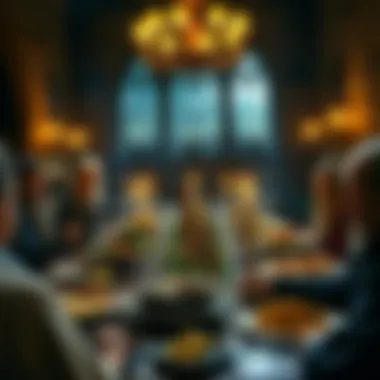
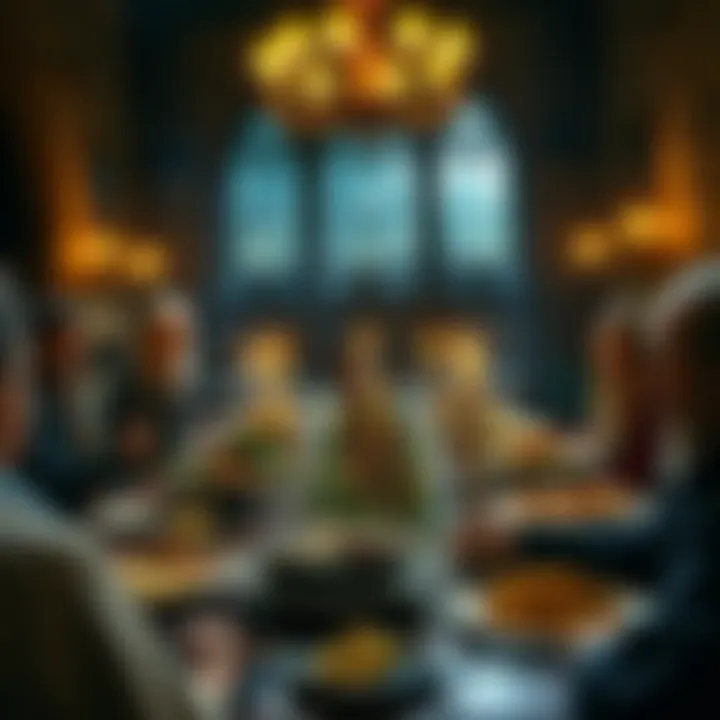
Intro
The Harry Potter universe is much more than wands, spells, and magical creatures. One of the lesser-discussed yet profoundly engaging elements is the cuisine presented throughout the series. Food in the Harry Potter books does not merely serve as sustenance; it acts as a cultural motif, grounding the story in rich traditions and memorable imagery. From the humble yet satisfying fare found in the Gryffindor common room to the lavish feasts in the Great Hall, the culinary landscape evokes a sense of belonging and community among the characters. These meals are teeming with stories—each dish a chapter, filled with history and flavor.
In this exploration, we delve into how J.K. Rowling seamlessly weaves food into her magical tapestry, influencing character development and plot progression. Furthermore, we’ll investigate recipes inspired by these fictional delicacies, empowering fans to recreate a slice of the wizarding world in their own kitchens. Let's embark on this delectable journey that invites readers to not only relish the flavors of Hogwarts but also appreciate the deeper connections these foods have with British culture and the stories they help narrate.
Preface to Food in the Harry Potter Universe
Food in the Harry Potter universe serves more than just the purpose of sustenance; it acts as a vital thread weaving together various facets of life within this enchanting world. From whimsical treats at the Wizarding World of Harry Potter to the heartwarming meals at Hogwarts, the significance of food is palpable. It defines relationships, traditions, and even character arcs, making it an integral part of the narrative.
In the realm of storytelling, food often acts as a silent yet powerful character. It provides a backdrop against which emotions play out — think of the comforting meals shared among friends or the lavish feasts that symbolize camaraderie. The way food is portrayed in these stories connects the reader to the characters’ experiences and cultural backgrounds. Additionally, food can signify cultural rituals or societal norms, shedding light on the customs of the Wizarding World. By unpacking the various culinary delights, we gain insights into the values, beliefs, and shared histories of witches and wizards.
Exploring food within Harry Potter has implications that extend beyond mere enjoyment; it compels readers to consider how the wizarding world's culinary practices reflect broader cultural themes. As we venture deeper, we shall uncover not only the dishes that dance off the pages but also the cultural inspirations behind them, inviting readers to engage with the text on a multi-layered level.
The Importance of Food in Storytelling
Food plays an undeniable role in storytelling, especially within the Harry Potter series. It transcends its basic function to nourish and becomes a medium for character development, plot progression, and thematic exploration. For instance, meals at the Great Hall are not mere gatherings; they signify unity among diverse characters. Harry, Ron, and Hermione enjoy their fare as a way to strengthen their bond, share adventures, and navigate challenges. Each dish comes laden with meaning, serving as an anchor point for pivotal moments in the story.
Moreover, food can evoke nostalgia and comfort, reflecting the emotional landscape of characters. Think about the sense of belonging that comes from a warm plate of treacle tart, or the excitement of indulging in Chocolate Frogs. These meals pull the reader into the wizarding experience, enriching the emotional undercurrents of the narrative.
Cultural Context and Inspirations
Delving into the cultural inspirations behind the dishes in Harry Potter reveals a rich tapestry of connections to British traditions and even beyond. The iconic Butterbeer, often associated with Hogwarts’ revelries, echoes classic British pub culture, inviting parallel explorations of social spaces and communal joy.
Many of the foods presented in the series reflect a blend of British culinary heritage and imaginative flair. Take, for instance, Pumpkin Pasties, which draw on seasonal harvest festivals, connecting readers to traditions of sharing food during celebratory times. In addition, the depiction of food serves as a bridge to understand the cultural exchanges amongst various magical creatures — a delightful heady pot of flavors that brings forth the essence of a cosmopolitan wizarding community.
By recognizing these layers of meaning and context, readers can appreciate how the culinary elements enhance the rich narrative of Harry Potter. It is through food that the familiar meets the fantastical, serving both as a grounding experience and a spark for the imagination.
Iconic Dishes from the Series
Food in the Harry Potter universe goes beyond mere sustenance. It serves as a bridge to emotions, cultural connections, and harbors stories within its flavors. The iconic dishes found within the series not only highlight the fanciful nature of the wizarding world, but also resonate with deeply rooted traditions that mirror our own. From the frothy allure of Butterbeer to the comforting warmth of Pumpkin Pasties, each dish embodies a slice of the magical life that reflects a broader narrative about camaraderie, heritage, and even conflict. These culinary feats invite us to explore the tapestry of cultural context, enriching our understanding of the characters and their experiences.
Butterbeer: A Wizarding Classic
Butterbeer is, without a doubt, the drink that every Hogwarts student craves. It is both wondrous and relatable, evoking memories of warm fires and shared laughter. Described as sweet, with a slight butterscotch flavor, Butterbeer is more than a beverage; it is a symbol of belonging in the wizarding community. The mention of it instantly transports readers to Hogsmeade, where friends gather to sip on their frothy mugs. Fans often fantasize about replicating this beloved drink at home, which speaks to its lasting impact.
An added note is that Butterbeer may carry specific memories from characters' lives. For Harry, it's a part of his initiation into the wizarding realm, while for Ron and Hermione, it's a comforting ritual during their escapades. The creamy texture and the tantalizing taste seem to wrap around the camaraderie shared among friends.
Pumpkin Pasties: A Hogwarts Favorite
Pumpkin Pasties can almost be seen as the ultimate snack for any Hogwarts student. Often consumed during travel to Hogsmeade or enjoyed during a lengthy study session, these little pies symbolize the spirit of home. Made from flaky pastry stuffed with pumpkin filling, these pasties capture the essence of the harvest season and evoke a sense of nostalgia.
The distinct flavor and portability make Pumpkin Pasties an ideal dish for students on the go. The act of eating them can bring about a feeling of comfort; students savoring a piece as they make their way through Hogwarts’ labyrinthine corridors makes for a warm scene. This dish even adds to the cultural significance, hinting at British culinary traditions, intertwining local fare and magical quests.
Chocolate Frogs: Treats with a Twist
Ah, Chocolate Frogs—what a delightful contradiction they are! These charming sweets combine the whimsy of magic and the joy of childhood. Each frog comes with a collectible card, making it not just a treat, but a mini-adventure all its own. The delightful packaging and the playful nature of these chocolates resonate with the idea of treasure hunting, sparking excitement every time one is opened.
It's fascinating how Chocolate Frogs reflect both indulgence and nostalgia. They embody a mix of playful curiosity while also highlighting deep-rooted elements of surprise and wonder—all crucial aspects of childhood and friendship. Whether you're chasing after one of the elusive cards or simply enjoying the rich chocolate, these sweets make their mark in the enchanting world of Harry Potter.
Cauldron Cakes: Magical Desserts
Speaking of treats, Cauldron Cakes stand out with their newfound reputation among the wizarding community. The very name evokes images of bubbling cauldrons and the excitement of magic in the air. These cakes, shaped like small cauldrons and often filled with a delightful icing or cream, are not just visual treats; they're demonstrations of the whimsy and artistry of magical cooking.
Cauldron Cakes enhance the celebratory atmosphere during feasts at Hogwarts, lending to the excitement of the festivities. They embody a light-hearted charm, inviting indulgence while blending beautifully with the other magical confections. For fans, replicating Cauldron Cakes could serve as an opportunity to tap into their own creativity, experimenting with flavors and decorations.
"Food is not just a source of nourishment; it’s a storytelling medium that pulls us into the heart of a culture, revealing its quirks and charms."
These dishes, as shared above, highlight not only culinary delights but also cultural markers that are infused with deeper meanings. They offer readers a taste of the magical experiences shared throughout the series, enhancing our connection with the characters and the world they inhabit.
With each dish, we see how food acts as a pivotal element in shaping narratives, reminding us of the ways in which we share our own stories around meals.
Regional Specialties and Their Significance
In the Harry Potter series, food isn't just a means to satisfy hunger; it serves to ground the narrative in a culturally rich tapestry that draws heavily on British heritage and influences from Ireland and Scotland. The foods encountered in this magical universe represent not just mere sustenance but a sense of identity and belonging. Through culinary traditions, we see the motifs of social stratification, nostalgia, and community woven throughout the storyline, making this section critical to understanding the broader implications of what food signifies in this world.
Regional specialties enhance the culinary landscape of Harry Potter, showcasing the diversity of flavors and traditions found across the British Isles. These dishes evoke the settings and circumstances that define wizarding life. By dissecting the regional variations, it becomes evident how food can embody both magical and mundane aspects of life, reflecting the characters' experiences and personal journeys.
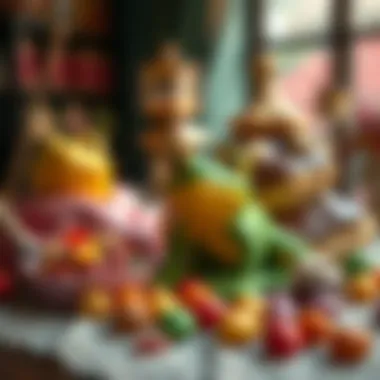
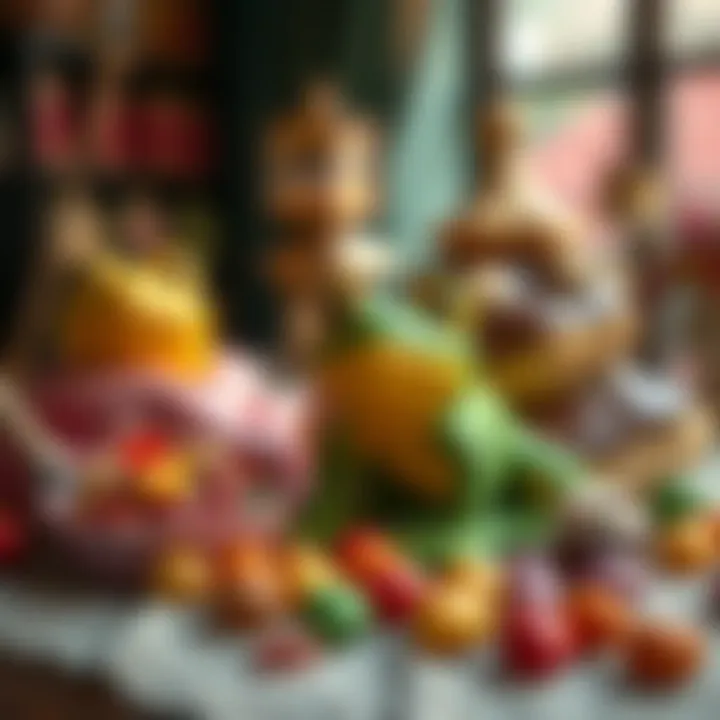
British Traditional Fare
British traditional fare features prominently in various scenes, from the bustling kitchens of Hogwarts to the warm and inviting atmosphere of the Burrow. Foods such as shepherd’s pie, roast dinners, and biscuits represent everyday life but are infused with a whimsical flair when depicted in the magical realm. The hearty potato, meat, and vegetable medley of a traditional shepherd’s pie echoes the comfort found in home cooking.
Often, ingredients are sourced right from the wizarding world’s landscape. For instance, the unique twist on a classic dish might involve using enchanted ingredients. Imagine shepherd’s pie where the potatoes are Whispering Yams, which sing softly as they are mashed! This attention to detail not only engages the reader’s imagination but deepens the connection to the characters who enjoy these meals together.
Furthermore, the British climate influences these dishes. Warm, hearty meals serve to combat the dreariness that often accompanies the weather, creating a cozy atmosphere ideal for storytelling. One can see the cozy atmosphere created around meals in the Great Hall, where vast tables overflow with food, reflecting the bounteous nature of the British countryside while reinforcing themes of friendship and community.
Irish and Scottish Influences
The influence of Irish and Scottish cuisine adds another layer to the magical food landscape. For instance, the traditional Irish stew highlights the themes of family and heritage that resonate deeply throughout the series. Ingredients such as lamb, potatoes, and carrots are staples in these regions and find their way into magical variations within the narrative.
In Scotland, haggis might be seen roaming the grounds of Hogwarts, perhaps in a whimsical engagement with the characters or serving as a lesson about embracing one's roots. Traditional Scottish celebratory foods, such as shortbread, not only add charm but also layers of cultural significance that resonate well with memorable events within the series.
In summary, exploring regional specialties not only enriches the culinary narrative of Harry Potter but places the characters firmly within a tangible cultural landscape. Each dish reflects the traditions and histories of its origins, providing readers with a profound sense of the interactions that take place over shared meals. The communal experience of food serves as a bridge connecting characters to each other and to their backgrounds, enhancing the depth and authenticity of J.K. Rowling's world.
Feasts and Celebrations in the Wizarding World
Food is not merely a necessity in the Harry Potter universe; it serves as a pivotal connector that enhances relationships, signifies celebration, and enriches the narrative. The various feasts and celebrations depicted throughout the series provide readers with a deeper understanding of both the wizarding culture and its values.
From the magnificent gatherings in The Great Hall to the festive traditions of Halloween and the elegance of the Yule Ball, each occasion emphasizes the importance of togetherness. These meals foster community spirit and offer insights into the personalities and connections of the characters involved. The whimsical nature of magic permeates these events, converting simple meals into experiences filled with enchantment, wonder, and camaraderie.
The Great Hall Banquets
The Great Hall, with its enchanting ceiling that reflects the sky outside, is the heart of Hogwarts where students and staff gather for meals. Banquets in the Great Hall are a spectacular display of magic and hospitality, showcasing sumptuous feasts that seem to appear as if by magic. These occasions are marked by grand spread of dishes - from roast beef and Yorkshire pudding to heaps of treacle tart. The sheer abundance and variety of food signify not just nourishment, but also the unity of the school community.
During special events like the start of the school year or end-of-term celebrations, the Great Hall transforms into an even more vibrant spirit of festivity, filled with laughter and cheer. It is a place where friendships are nurtured, and rivalries are set aside, encapsulating the essence of Hogwarts life.
Halloween Celebrations
Halloween at Hogwarts is crafted into a charming affair filled with delightful and eerie elements. It’s tricky to pinpoint whether more excitement comes from the food or the atmospheric decorations, but one thing’s certain: every Hogwarts student eagerly looks forward to the Halloween feast. Ghostly pumpkins, enchanted sweets, and rich spiced dishes fill the long tables, creating an atmosphere that’s both thrilling and inviting.
The October night is alive with the sights and sounds of revelry. It’s a time when even the ghosts of the castle get into the spirit of the holiday. The meal, accompanied by live music from the enchanted instruments, transforms a simple dinner into a spectacular celebration, allowing students to momentarily forget their studies and immerse themselves in fun.
Yule Ball: An Exquisite Affair
The Yule Ball, held during the Triwizard Tournament, is a symbol of cultural elegance and formality in the wizarding world. It showcases not only the culinary expertise of Hogwarts but also highlights the important traditions surrounding gathering for special occasions. The food served at the Yule Ball often reflects the sophistication of the event, with a menu that includes exquisite dishes that mirror the extravagant setting.
Lavish desserts, perfectly crafted pastries, and champagne-like beverages filled the tables, emphasizing the spirit of celebration under the stars. But it’s not just about the food – the Yule Ball is firstly a celebration of relationships, with students finding joy and sometimes heartache in the dance and social interactions that take place. The culinary experience enhances the magic of the evening, making the event memorable for every attendee.
The Role of Food in Character Development
Food plays a pivotal role in shaping character relationships and development throughout the Harry Potter series. It is not merely sustenance; it serves as a backdrop for major interactions and growth among characters. Meals in the wizarding world often symbolize friendship, support, and even conflict. Through culinary experiences, Rowling conveys intricate themes of belonging, love, and identity, enhancing the narrative's emotional depth.
Harry, Ron, and Hermione’s Shared Meals
Harry Potter's trio—Harry, Ron, and Hermione—often gather around communal meals, illustrating their deepening bonds. These shared meals at Hogwarts are more than just times to eat; they're moments of connection, filled with laughter, camaraderie, and the occasional debate. The great feasts in the Great Hall, overflowing with unique treats, serve as a pivotal juncture in their relationships.
During their first year, for instance, meals played a crucial role in shaping their dynamic. Harry often finds comfort in the company of his friends, particularly during times of peril. The food serves as a physical symbol of their growing friendship and mutual support. Likewise, Ron introduces Harry to foods that embody the warmth of the Weasley home, such as home-baked goods like treacle tart, which serves to convey Ron's familial love and loyalty. Hermione, on the other hand, brings an air of sophistication to their meals, selecting dishes that reflect her cultured upbringing.
"Food is a central thread in the tapestry of their friendship, deepening their understanding of each other beyond the surface."
The Weasley Family Table
The Weasley family table represents warmth, hospitality, and the essence of a tight-knit household. Meals as a regular occurrence for the Weasleys are never ordinary. When Harry joins them, he experiences a stark contrast to his upbringing. Here, food is abundant; each meal is accompanied by boisterous conversations and a myriad of dishes, showcasing Mrs. Weasley’s culinary prowess.
This environment fosters a sense of belonging for Harry, who often feels like an outsider due to his past. The Weasley's table symbolizes comfort and acceptance, where each family member plays a role in meal preparation—something Harry yearns for. The whimsical yet chaotic scene of the Weasley kitchen, filled with the scents of magical cooking and the laughter of siblings, emphasizes the significance of food in family and unity.
- Culinary Diversity: Each meal brings flavors from their diverse backgrounds, hinting at their cultural connections.
- Meals as Rituals: The Weasley gatherings often become rituals, reinforcing familial bonds in times of celebration or strife.
Snape’s Complex Relationship with Food
Severus Snape’s relationship with food is layered and complex, reflecting his tumultuous character arc. Throughout the series, his interactions with food unveil hidden vulnerabilities. For instance, Snape is often seen in the Potions classroom crafting elaborate concoctions, where food and potions intertwine. However, the stark contrast between his esteemed role as Potions Master and his meager personal meals speaks volumes about his character.
His experiences with food dwell in the shadows of his childhood. Often, there are subtle hints of neglect, as he is depicted as disinterested in the social aspects of meals, preferring solitude over shared dining experiences. The meals he consumes lack warmth, mirroring the emotional distance he maintains from the other characters.
Ironically, the process of potion-making itself can be seen as a culinary act, where ingredients must be perfectly aligned to create something magical. Just as with food, the blend of Snape's harsh exterior and complex emotions reveals his depth. Through Snape’s character, Rowling illustrates how food can signify trauma, loneliness, and the sometimes bitter taste of unfulfilled dreams.
Food and Class Distinctions
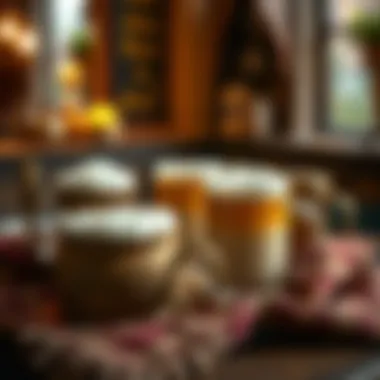

In the Harry Potter series, food is not just sustenance; it’s a vivid reflection of social structure and class dynamics within the magical community. The juxtaposition between the lavish feasts experienced by wizards, particularly at Hogwarts, and the menial fare consumed by house elves lays bare the inequalities present. This section delves into how culinary choices highlight class distinctions, encouraging a deeper understanding of the characters and their backgrounds.
House Elves and Culinary Labor
House elves, like Dobby and Kreacher, are deeply entangled in the kitchen’s tapestry. These magical beings provide invaluable culinary labor, their skills rarely recognized as anything but subservience. They manage the daily meals at Hogwarts and serve in affluent wizarding households, often subject to harsh conditions without any pay. This underlines a harsh truth about the magical society—food preparation becomes an expression of power dynamics. When Harry, Ron, and Hermione share meals, it’s a stark contrast to the lonely existence of house elves, who prepare grand feasts yet partake only in the scraps or are denied a dining seat at the table.
Interestingly, the series positions house elves' meals as simple yet nourishing, highlighting their role in representing the labor class. Often, what's served to them is humble and filled with the essence of survival rather than the opulence of their wizarding masters. This dynamic is critical because it opens dialogue about social ethics and responsibility within the magical realm.
Luxury vs. Everyday Fare
The Harry Potter universe does a fine job contrasting luxury with everyday fare. The grand banquets in the Great Hall, brimming with countless dishes, exemplify wizarding abundance. Dishes like roast beef, treacle tart, and fruit crumbles embody the wealth and privilege of wizarding society. This representation speaks volumes about cultural expectations and aesthetic presentation in food for the upper class.
On the other hand, we see what everyday wizards consume. For example, when we venture outside Hogwarts, we catch glimpses of the dining habits of the less affluent. The Burrow, home of the Weasley family, represents wholesome, unpretentious meals that showcase a different kind of love—simple yet fulfilling, emphasizing family and togetherness rather than extravagance.
The differences in food reflect the opportunities available to different classes. Wizards of wealth indulge in magical delights like roast unicorn or enchanted soufflés. In contrast, those in lower social standings may settle for simpler fare that lacks the glamour but carries family tradition. This contrast is not merely aesthetic; it serves to define the characters’ identities, their relationships, and their struggles.
"The differing culinary experiences help ground the narrative in real-world social issues, making the magical more relatable yet complex."
Through these culinary narratives, we’re invited to ponder the relationships between food, class, and identity—not only within the pages of J.K. Rowling's work but in our own world too.
Magical Cooking Techniques and Ingredients
In the heart of the wizarding world, cooking transcends mere nourishment; it becomes an art steeped in mystery and enchantment. The integration of magical cooking techniques with traditional culinary practices makes each dish not just a meal but a veritable experience layered with cultural significance—and this section explores how these magical elements enliven the culinary landscape of Harry Potter.
Potions and Culinary Arts
When one thinks of potions, an array of vibrant, bubbling concoctions come to mind, often filled with mystical properties that can enhance or alter the mind, body, or spirit. The art of potion-making shares many similarities with cooking, requiring precision, timing, and an instinct for flavor and texture. Just as a chef balances salt and sweetness, a potion master must navigate the delicate interplay of ingredients to achieve the desired effect.
In Hogwarts, Potions Class is an essential curriculum as much as the culinary arts are caught in the depths of the cauldron. A potion's Erfolg heavily relies on the quality of ingredients utilized—their origin, preparation, and magical potency.
Some commonly encountered potion ingredients in the wizarding world include:
- Mandrake Root: Widely known for its restorative properties, it is essential in both culinary and potions use for enhancing flavors or curing ailments.
- Powdered Dragon Horn: Often used for elixirs, this ingredient has a rich flavor profile and extraordinary magical properties.
- Aconite: A tricky addition, while it has potent magical attributes, caution is paramount due to its toxic nature.
The lines blur where potion-making merges with the culinary arts, showing how the two realms can create synchronicity in the kitchen, enhancing the flavors one serves up.
Herbs and Magical Elements
Nature provides a bountiful array of herbs, many of which possess inherent magical properties, drawing on centuries of folklore and tradition. In the wizarding realm, these herbs transform mundane meals into extraordinary experiences. For example, using Wormwood Essence not only adds a pungent flavor; it can also imbue a dish with qualities that provoke dreams or inspire creativity.
Some notable herbs celebrated in both the Harry Potter universe and culinary practices include:
- Basilisk Bane: Known for its uses in healing potions, it also lends an aromatic flavor that can enliven a simple stew.
- Lavender: Frequently recognized for its calming properties, lavender enhances desserts like Tormenta Fudge, marrying flavor with function.
- Thyme: This herb, humble yet versatile, has been used in potion-making for centuries, grounding flavors with its earthy profile while also providing medicinal qualities.
In the hands of skillful chefs and potion-makers alike, these herbs can conjure not just nourishment but a symphony of flavors and effects. Through understanding the magical significance and culinary applications of these plants, one can unlock new dimensions within their cooking journey—an exploration that ties culture, tradition, and enchantment together.
"Food is a mirror reflecting the culture and creativity of its creator."
The wizarding world illustrates that culinary art is as much a craft as it is a form of magical expression.
Recipes Inspired by the Wizarding World
The world of Harry Potter is not only a realm of magic and adventure but also a culinary delight that captures the imagination. Recipes inspired by the Wizarding World allow fans to engage with the series in a tangible way. They offer a chance to replicate the flavors and aromas so vividly described in the books and films. More than just meals, these recipes create a connection to the characters and settings, bringing a piece of Hogwarts into our own kitchens. This section will explore how crafting these dishes can ignite one's creativity and evoke nostalgia while highlighting skills and unique ingredients from magical cuisine.
Creating Butterbeer at Home
Butterbeer is perhaps the most famous beverage in the Harry Potter universe, enjoyed by students and visitors at Hogsmeade. With its butterscotch flavor and warm, comforting aura, it’s a drink that invokes images of cozy pub gatherings and laughter. To make Butterbeer at home, you need simple ingredients, many of which might already be in your pantry.
Ingredients:
- 1 cup of cream soda
- 2 tablespoons butterscotch sauce
- 1 tablespoon heavy cream
- A pinch of cinnamon or nutmeg
Method:
- In a glass, combine the cream soda and butterscotch sauce. Stir gently until mixed well.
- In a separate bowl, whisk the heavy cream until it becomes frothy, adding a sprinkle of cinnamon or nutmeg for an extra touch of magic.
- Pour the cream soda mixture over ice, then spoon the whipped cream on top. Enjoy warm or chilled like a wizard on a sunny day.
This recipe invites a sense of whimsy into any gathering, making it feel more like a magical experience.
Pumpkin Pasties Recipe
Pumpkin pasties are the perfect snack for Hogwarts students crammed in the Hogwarts Express. These hand-held treats combine flaky pastry with a sweet and savory filling, making them ideal for feasting on while traveling.

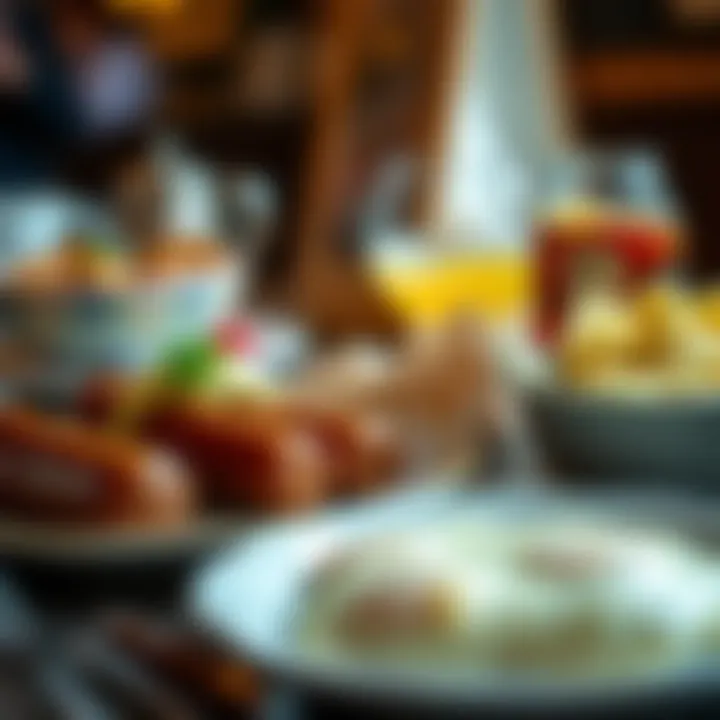
Ingredients:
- 1 cup pumpkin puree
- 1 teaspoon sugar
- 1/2 teaspoon cinnamon
- 1/4 teaspoon nutmeg
- 1 package of pre-made pie pastry
- 1 egg (for egg wash)
Method:
- Preheat your oven to 375°F (190°C).
- In a bowl, mix the pumpkin puree, sugar, cinnamon, and nutmeg.
- Roll out your pastry and cut it into circles, about 4 inches in diameter.
- Place a spoonful of the pumpkin mixture in the center of each circle, fold over, and crimp the edges to seal.
- Brush the tops with egg wash to give them a golden finish.
- Bake for about 25 minutes or until golden brown.
These pasties ignite a childlike excitement and work well as appetizers or snacks for gatherings.
How to Make Chocolate Frogs
Chocolate frogs represent a delightful combination of snack and collectible within the Harry Potter series. Each frog comes with a famous witch or wizard trading card, making them suitable for all ages and occasions. While the magical elements may be fictional, the fun of making your own chocolate frogs is very real.
Ingredients:
- 1 cup milk chocolate chips
- Frog-shaped molds
- Edible glitter (optional)
Method:
- Melt the chocolate chips in a microwave-safe bowl in 30-second intervals until fully melted.
- Carefully pour the melted chocolate into the frog molds, making sure to fill them completely.
- Optionally, sprinkle edible glitter before the chocolate sets for a touch of enchantment.
- Allow the chocolate to harden in the fridge for about 30 minutes.
- Once set, pop them out of the molds and enjoy!
These chocolate frogs add a playful twist to parties or gatherings, reminding us of the joy in reliving our favorite moments from the series.
The Legacy of Harry Potter Cuisine
The culinary legacy of the Harry Potter universe extends far beyond the pages of J.K. Rowling's beloved books. It has taken root in the hearts and kitchens of countless fans, planting seeds of creativity and inspiration. The magical meals and sweet treats not only provide an immersive reading experience but also reflect underlying themes of friendship, tradition, and cultural heritage.
Food in Harry Potter serves as a bridge connecting characters and readers alike, allowing us to engage with the rich narrative in tangible ways. The way that memories and experiences are woven into meals is a recurring motif throughout the series. Each dish holds significance, often marking milestones in the characters' lives or signifying unity and comfort. The legacy of these foods encourages a connection that can spark joy and debate, making readers eager to recreate these dishes in their own kitchens.
The process of preparing and consuming food opens a door to cross-generational culinary practices and bonding, particularly within families, echoing the traditions presented at the Weasley family table or during Hogwarts feasts. This deeply held legacy fosters not only culinary creativity among fans but also a sense of belonging in the wider magical community.
Influence on Modern Culinary Trends
The Harry Potter series has profoundly influenced contemporary culinary trends, especially in the realm of fandom cuisine. The whimsical elements of the wizarding world have inspired a myriad of chefs and home cooks to experiment with ingredients and presentation methods that seem almost magical themselves. Concepts such as using edible glitter or creating dishes that mimic potions have proliferated, allowing fans to feel like they’re part of the magic.
One can't help but notice how Instagram and food blogs have recently exploded with recipes for beloved dishes like Butterbeer and Pumpkin Pasties. These adaptations often feature innovative twists to classic recipes, reflecting the fancy, imaginative nature of the series. For instance, using maple syrup in Butterbeer has become a popular staple, and many home bakers have even created Gluten-Free versions of Pumpkin Pasties to ensure everyone can partake in the fun.
Moreover, popular venues like the Wizarding World of Harry Potter theme park have brought these flavors to life, allowing fans to experience the magic on their tongues. These ventures have not only catered to longtime fans but have drawn in foodies who may not even be particularly well-versed in the wizarding world.
By engaging with the magic on a plate, culinary trends continue to evolve, encouraging creativity while creating a shared experience that resonates with diverse audiences.
Food as a Cultural Phenomenon
Food, particularly as depicted in Harry Potter, serves as a cultural touchstone, exploring broader societal themes that resonate across generations. The dishes and drinks that populate the narrative often reflect aspects of the British cultural landscape, highlighting the significance that meal-sharing holds within community building.
From the classic roast dinners of the Great Hall to Hermione’s attempt to bring a touch of sense to the chaos with her S.P.E.W. (Society for the Promotion of Elfish Welfare) initiatives, food becomes a lens through which to examine issues of class, labor, and social justice within the wizarding world. It chronicles how different characters interact with food and its implications on their relationships and values.
Moreover, events such as the Yule Ball introduce elaborate feasts that elevate cuisine to a theatrical art form, merging culinary excellence with class structure and social expectations. Points of contention, such as the treatment of house elves and how they contribute to the culinary narrative, ignite discourse on ethical consumption and labor in our world.
The cultural impact of Harry Potter cuisine is felt not just in the immediate fandom, but also within academic circles studying the intersections between literature, food, and society. Scholars scrutinize how these magical dishes represent broader narratives and reflect cultural phenomena, making the Harry Potter world an important area of study as food trends continue to evolve in popular culture.
"Food is not just a way to satisfy hunger; it’s a means of connecting, a story shared among those gathered around the table."
In summary, the legacy of Harry Potter cuisine reaches far and wide, fostering culinary creativity, encouraging a connection with cultural narratives, and transforming the ways we view food in our own lives.
Finale
In closing, the exploration of food within the Harry Potter universe reveals a rich tapestry woven with cultural significance, tradition, and narrative depth. Food is not just a means of sustenance for the characters, but a crucial element that enriches the storyline and enhances character development. Throughout the series, meals often serve as the backdrop to important interactions and emotions, reflecting the values of the wizarding world and the connections between characters.
Reflections on Food in Harry Potter
When we reflect on the culinary elements in the Harry Potter series, it's clear that each dish has its place within the narrative fabric. For instance, the simple act of sharing a meal can symbolize trust, friendship, and belonging. The Weasley family dinners are a prime example; laden with hearty food and warmth, they offer a stark contrast to the often cold and stern environments of the wizarding world. These reflections remind us that meals can be monumental in shaping relationships and experiences, just as they do in our own lives.
Further, the magical aspect of food—the enchanted cakes, the transformative qualities of potions—heightens our appreciation of meal times as not just necessary, but as opportunities for magic and wonder, blurring the lines between reality and fantasy.
Encouraging Culinary Exploration
The journey through Harry Potter’s culinary world beckons enthusiastic fans to take the plunge into their own kitchens. Encouraging culinary exploration means inviting readers to recreate the enchantment at home. By experimenting with recipes inspired by the series, fans can connect with the narrative on a deeper level while discovering their own culinary skills.
Trying out Butterbeer or crafting Pumpkin Pasties is not merely an act of cooking; it's an invitation to live the magic of Hogwarts. By incorporating traditional ingredients and techniques, one can experience a bit of the wizarding world within their own walls.
Moreover, engaging in cooking allows for moments of creativity and joy, sending the message that food can connect us to beloved stories, traditions, and even to one another. So grab your wand, or in this case, your whisk, and dive into the enchanting realm of Harry Potter cuisine.
"Cooking is like magic; if you believe you can, you often can make delicious things happen."



